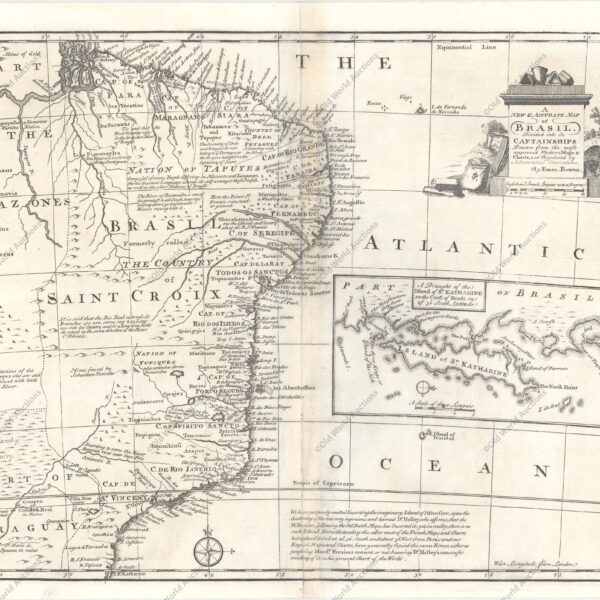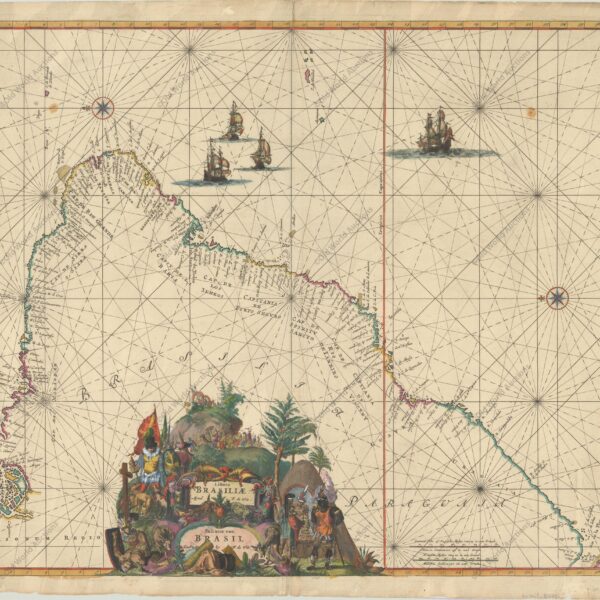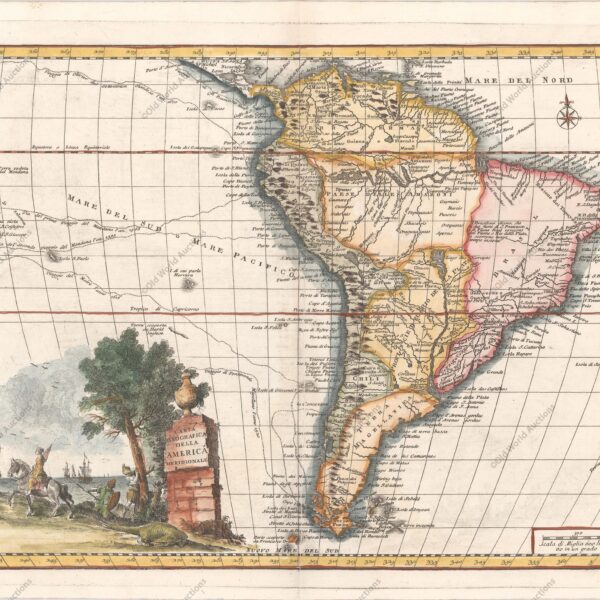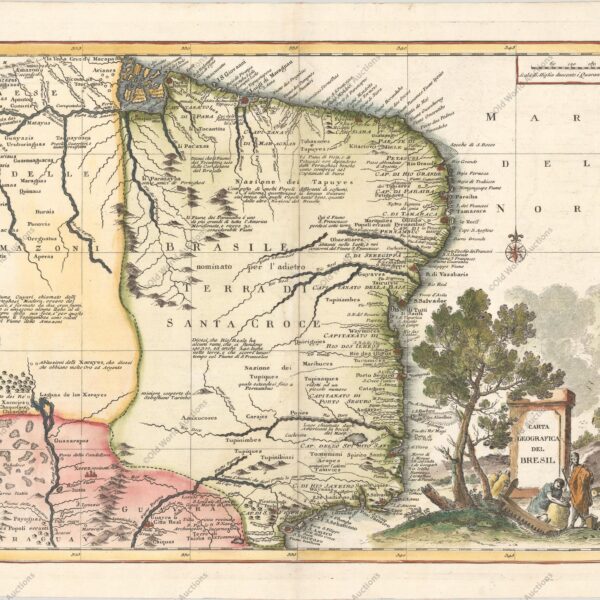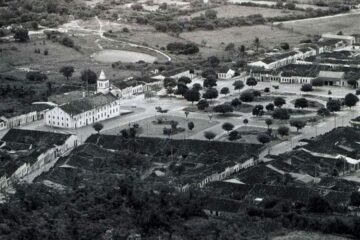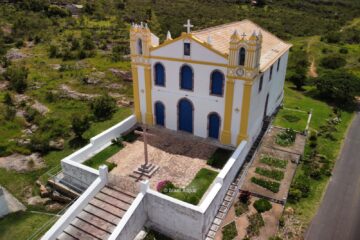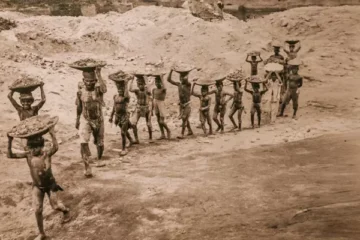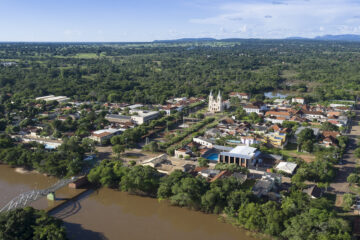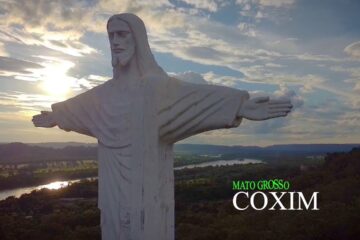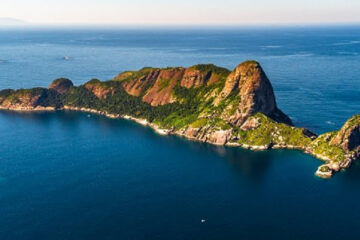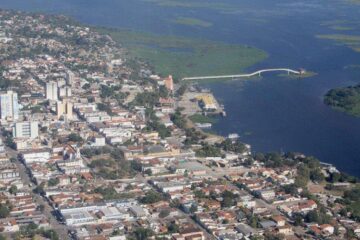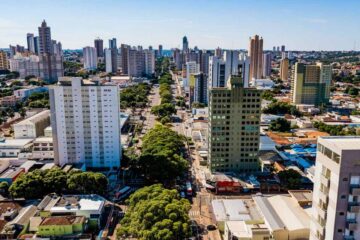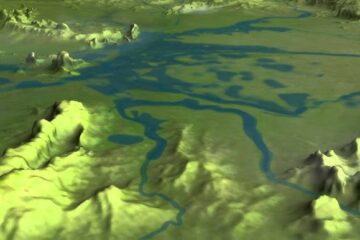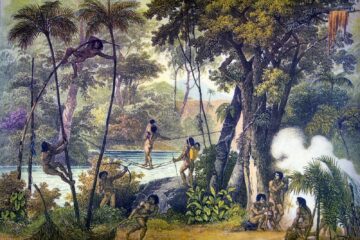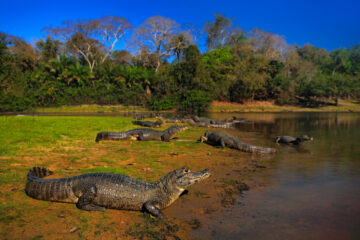Map of Western Hemisphere – America 1550 – Cosmographiae Universalis One of the Most Important 16th Century Maps of the New World “Tabula Novarum Insularum, qua Diversis Respectibus Occidentales & Indianas Vocant”, Munster, Sebastian Sebastian Munster (1489 – 1552) was one of the three most renowned cartographers of the sixteenth century, […]
Historical Maps
From the 16th century, the historical cartography of Brazil begins with the first representations that are part of the planispheres or maps of the Americas in editions of Ptolemy’s Geography and works by travellers.
These representations of Brazil have illustrations of indigenous scenes, fauna and vegetation, information obtained, at first, through Américo Vespúcio, who accompanied the first Portuguese expeditions to the Brazilian territory, and, later, through travellers and navigators.
The cartography of this period also records the first names of the country: Terra de Santa Cruz, Terra Incógnita, Antropófagos, Terra dos Papagaios and Brasil. These maps were produced by cartographers such as Ruysch, Waldseemüller, Ortelius, Ruscelli, Forlani, Gastaldi and Hulsius. Still in the 16th century, the concern with the French attacks on the Brazilian coast began.
Examples of these episodes can be found in Gastaldi’s maps, exposing the barter between the French navigators and the Brazilian natives, and in the works of the religious and cosmographer André Thevet, who accompanied Nicolas Durand de Villegagnon during the time he was in Rio de Janeiro, with the foundation of the French Antarctic colony.
Between 1580 and 1640, Portugal was part of the Iberian Union, under the Filipino dynasty.
Thus, all the Portuguese colonies also belonged to the Spanish Crown, which favoured the presence of the French, English and Dutch on the northern and north-eastern coast of Brazil.
To defend the Iberian domains in America, the Philippine Crown allowed the Luso-Brazilians to go beyond the limits established by the Treaty of Tordesillas, advancing towards the Amazon delta.
These conquests are recorded in the 17th century Portuguese cartography, by the notable astronomers Cochado and Albernaz I, showing the forts built and the cities founded, as well as the English and Dutch fortifications destroyed.
Still referring to the 17th century, the Portuguese handwritten cartography is displayed, with the charts of Antônio Vicente Cochado, Antônio Sanches, João Teixeira Albernaz I and his grandson João Albernaz II.
All maps detail toponyms richly located on the coast, from Belém to the Rio da Prata.
The map of Brazil by Albernaz II (1666) deserves, however, to be highlighted because, besides having, like the others, a large quantity of toponyms on the Brazilian coast, it highlights the city of São Paulo and, in the south of the territory, the Jesuit missions.
I could not fail to show the beautiful Dutch cartography of north-eastern Brazil, between 1624-1654.
The map, Perfect Caerte der Gelegentheyt van Olinda de Pharnambuco Maurits-stadt ende t’Reciffo and made by Cornelis Golijath, is considered the best cartographic production under Dutch rule in north-eastern Brazil.
In the 18th century, there is a sketch about the Luso-Brazilian explorations of the Brazilian interior, which is part of the set “Cartas Sertanistas” (Letters from the Backlands) (Cortesão, 1957-1971).
These sketches, existing in the National Library, indicate Jesuit missions destroyed by sertanistas and/or bandeirantes and roads in search of mineral wealth in the interior of Brazil.
Still from the 18th century, we also find French cartography, which became predominant in that period with the foundation of the Royal Academy of Sciences by Colbert and the construction of the astronomical observatory in Paris.
Among the cartographers chosen were Guillaume de L’Isle and Jean Baptiste Bourguignon d’Anville, author of one of the best eighteenth-century charts representing South America.
The notoriety of Guillaume de L’Isle is due to the fact that he observed errors of the Portuguese in the calculations of the longitudes of Brazil.
A member of the Royal Academy of Sciences of France, Guillaume de L’Isle, in 1720, noted that the Portuguese calculations exceeded the Lusitanian domains in South America according to the Treaty of Tordesillas.
As is well known, the Iberian Crowns sought a solution to the question of the boundaries of their domains in South America.
The result of these negotiations was the Treaty of Madrid, signed in January 1750.
One of the original copies of the Map of the Cortes, the cartographic document that served as the basis for the treaty, is part of the exhibition.
Thus, mixed commissions were formed to survey and demarcate the borders of the northern and southern regions in South America. Portugal and Spain hired specialists (cosmographers, astronomers, military and other specialists) from various European nations to carry out these tasks.
From these works, a significant amount of cartographic documents (maps, views, reports, diaries) were produced.
The exhibition displays part of this collection produced by the members of these mixed commissions on the Portuguese side.
The 19th century begins with two leaves from the handwritten atlas Guia dos Caminhantes, made by Anastácio de Santana, in Salvador (1817).
The first, the title page, contains geographical data and a panoramic view of the city of Salvador.
The second is a map of Brazil with the north facing the right bank. Besides being didactic, this atlas represents one of the first initiatives in the mapping of Brazil.
In this period, cartographic production increases. Maps of provinces and of the national territory, topographic plans, hydrographic surveys of the rivers, of the Amazon and Prata basins and frontier charts are composed.
In the twentieth century, after resolving several border issues over four centuries, and with the national territory already configured, the route ends with the Carta geographica do Brasil (Geographic Chart of Brazil), on the scale 1:7,500,000, published by the Engineering Club in 1922, in commemoration of the centenary of Brazil’s Independence.
This map is the reduction of the letter of Brazil in the International Letter of the World to the Millionth, made according to international standards established at the International Congress of Geography in Paris in 1913.
Map of Western Hemisphere – America 1660
Map of Western Hemisphere – America 1660 De Wit’s Uncommon Carte-a-Figures Map of the Americas “Nova Totius Americae Descriptio”, Wit, Frederick de An uncommon and splendid carte-a-figures map of the Americas. The map combines many different sources including the Luke Foxe model of the island of California. The only hint of […]
Map of Western Hemisphere – America 1719 – Atlas Historique
Map of Western Hemisphere – America 1719 – Atlas Historique Spectacular Wall Map Celebrating the New World “Carte Tres Curieuse de la Mer du Sud Contenant des Remarques Nouvelles et Tres Utiles non Seulement sur les Ports et Iles de Cette Mer…”, Chatelain, Henry Abraham This spectacular wall map is richly […]
Map of Western Hemisphere – America 1730
Map of Western Hemisphere – America 1730 “Totius Americae Septentrionalis et Meridionalis Novissima Repraesentatio quam ex Singulis Recentium Geographorum Tabulis Collecta Luci Publicae Accommodavit”, Homann, Johann Baptist This attractive map is a revision of the elder Homann’s 1710 map of the Americas. After his death in 1724, his son (Johann Christoph […]
Map of Western Hemisphere – America 1697
Map of Western Hemisphere – America 1697 Allard’s Elaborate Map of the Western Hemisphere “Recentissima Novi Orbis, sive Americae Septentrionalis et Meridionalis Tabula”, Allard, Carel Sumptuous map of the Americas features a dramatically decorative title cartouche showing an Amazonian queen surrounded by riches, a sugar cane field and exotic animals. […]
Map of Western Hemisphere – America 1579 – Theatrum Orbis Terrarum
Map of Western Hemisphere – America 1579 – Theatrum Orbis Terrarum Ortelius’ Influential Map of the New World – Second Plate in Contemporary Color “Americae sive Novi Orbis, Nova Descriptio”, Ortelius, Abraham This is one of the most famous maps of America, and one that had enormous influence on the […]
Map of Brazil 1747
Map of Brazil 1747 “A New & Accurate Map of Brasil. Divided into its Captainships Drawn from the Most Approved Modern Maps & Charts…”, Bowen, Emanuel Copper engraved map with good detail along the coastal areas with scores of place names. The map covers the region between northern Paraguay and north […]
Map of Western Hemisphere – America 1592
Map of Western Hemisphere – America 1592 – Grands Voyages “Americae Pars Magis Cognita”, Bry, Theodore de This copper engraving is from a remarkable series of publications, illustrating voyages of discovery and travels of exploration to various parts of the world. The project was begun by Theodore de Bry of Frankfurt, in […]
Map of the Western Hemisphere from 1623
Map of the Western Hemisphere from 1623 This is a very rare derivative of the important Hondius map of 1618. The engraver is unknown, although it is closely copied from Picart’s version of 1644, which in turn was derived from Jansson’s map of 1623. North America retains peninsular California and […]
Maps of Western Hemisphere – America 1581 – Theatrum Orbis Terrarum
Maps of Western Hemisphere – America 1581 – Theatrum Orbis Terrarum Ortelius’ Influential Map of the New World – Second Plate “Americae sive Novi Orbis, Nova Descriptio”, Ortelius, Abraham This is one of the most famous maps of America, and one that had enormous influence on the future cartography of the […]
Map of Western Hemisphere – America 1659 – Pierre d’Avity’s Les Etats, Empires, Royaumes… du Monde
Map of Western Hemisphere – America 1659 – Pierre d’Avity’s Les Etats, Empires, Royaumes… du Monde Very Rare Derivative of Hondius’ Map of the Americas “America Noviter Delineata”, Anon. This is a very rare derivative of Hondius’ important map of 1618. The engraver is unknown though it is closely copied from […]
Map of the Brazilian coastline from 1678
Map of the Brazilian coastline from 1678 “Littora Brasiliae / Pascaert van Brasil”, Wit, Frederick de This magnificent map of Brazil is primarily a sea chart with details confined to the coastline. Oriented with north to the left by two fine compass roses, it covers the Brazilian coastline from the mouth […]
Map of Eastern Brazil 1664
Map of Eastern Brazil 1664 – Grooten Atlas Important Map of the Brazilian Coast “Praefecturae Paranambucae Pars Meridionalis”, Blaeu, Johannes This fine map of the Brazilian coast is richly decorated with a scene of natives with a look-out tower and a huge fleet of ships. With north oriented to the right, the […]
Map of South America from 1750
Map of South America from 1750 – Atlante Novissimo… “Carta Geografica della America Meridionale”, Albrizzi, Girolamo Beautifully engraved, Italian edition of Delisle’s map of South America, extending from Nicaragua to Tierra del Fuego. Place names in South America are focused primarily along the coasts and along the Amazon and Parana Rivers. Two […]
Map of Brazil from 1698
Map of Brazil from 1698 – Istoria delle Guerre del Regno del Brasile A Rare Map of Brazil from the Santa Teresa “Il Regno del Brasile Parte Nobilissima del Mondo Nuovo…”, Santa Teresa, J. J. de This splendid map of the Brazil, including portions of neighboring countries, was one of 23 […]
Map of Brazil from 1750
Map of Brazil from 1750 – Atlante Novissimo… “Carta Geografica del Bresil”, Albrizzi, Girolamo This is a handsome Italian map of Brazil based on the cartography of Delisle. There is very good detail along the coastlines and a fair amount of information on the interior with numerous notations and the locations of […]






